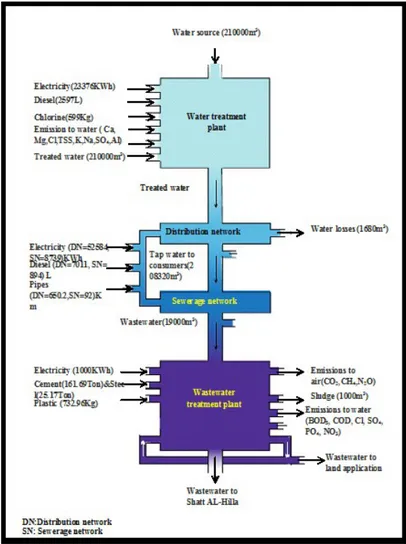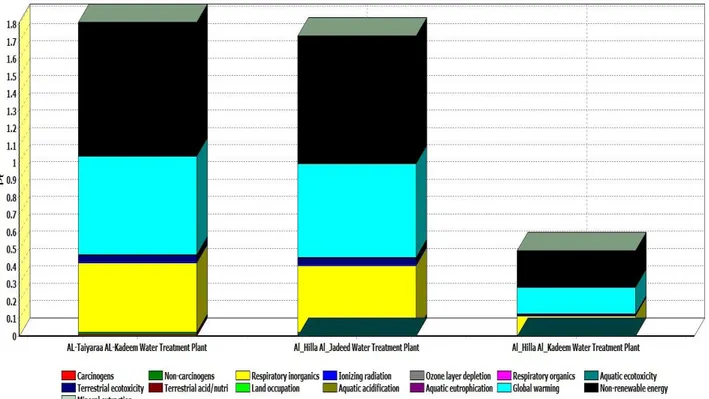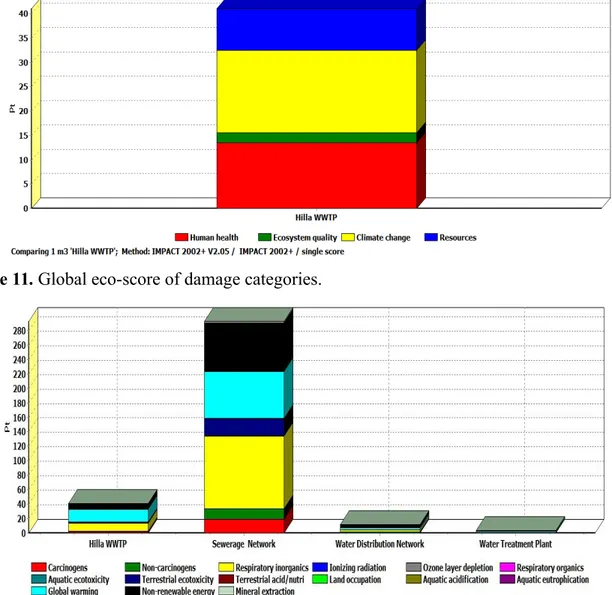JOURNAL OF
ENVIRONMENTAL HYDROLOGY
The Open Access Electronic Journal of the International Association for Environmental Hydrology
On the World Wide Web at http://www.hydroweb.com
VOLUME 23
2015
SELECTING SUSTAINABILITY INDICATORS OF URBAN
WATER SYSTEMS:
CASE STUDY OF AL-HILLA CITY, IRAQ
M.A. Alanbari 1 H. Q. Alazzawi 1
N.A. Al-Ansari 2
S. Knutsson 2
1 College of Engineering. Babylon University, Iraq 2 Department of Civil, Environmental and Natural
Resources Engineering, Luleå University of Technology, Lulea, Sweden
The present study used environmental criteria to appraise the sustainability of the urban water system (UWS) of Al-Hilla city, Iraq. The study focused on the assessment of the environmental impact and damage to the urban water system. Environmental criteria of sustainability included a number of indicators. These indicators were selected using tools of sustainability analysis, where life cycle assessment (LCA) was used to select and analyze the environmental indicators by applying SimaPro7.1.8. LCA. The results for urban water system in Al-Hilla city showed that water treatment plants (WTPs) and distribution network were most sustainable compared with sewerage network and waste water treatment plants (WWTP). WTPs impact and damage on the environment and distribution network was 4 and 11.5 points respectively, while Al-Hilla WWTP and sewerage network was 41 and 291 points respectively, for delivery of one cubic meter of potable water at the point of consumption or treatment of one cubic meter of wastewater. In addition, the study showed that most of the effects were due to electricity consumption, pumping raw water and clean water, chemical use (such as chlorine), pipes used in water distribution and sewage collection networks, and diesel used for plant operation.
INTRODUCTION
Water is a natural resource vital both for humans and ecosystems which is becoming increasingly scarce due to increasing demand due to population growth rate, increasing industrial and agricultural activities as well as the effect of climate change. In this context, the provision of a continuous supply of clean water and sanitation to the public is particularly challenging for urban water systems, demanding a sustainable management of the water resource (Lemoset al., 2013). Good water management could contribute to minimize energy consumption and related climate gas emissions (Berrini et al., 2010). Integrated Urban Water Management (IUWM) is a concept that is based on the recognition that the urban water system is best designed and managed in a holistic manner. The environmental impacts of urban water systems or some of its stages have been analyzed from a life cycle perspective, using Life Cycle Assessment (LCA) (Lemos et al., 2013).
Life Cycle Assessment (LCA) is a standard international tool, ISO 14040, used to evaluate the environmental impact of products, processes, and services. It considers the entire life cycle, from raw material extraction, to manufacture, distribution, use, end of life treatment, recycling and eventually, disposal. In addition, there have been several studies based on Life Cycle Assessment (LCA) in recent decades to determine the environmental impacts resulting from water production, water transport to the customer and wastewater treatment; however, few studies have assessed the whole urban water cycle (Amores et al., 2013). SimaPro 7 software was used for the inventory and database on resources consumption and environmental emissions in the present LCA (PRé Consultants, 2010).
The aim of this study is to select the sustainability indicators for the urban water system in a city. In this case Al-Hilla city, Iraq was considered (Figure 1) to appraise the sustainability of its water system. This was achieved by reviewing the existing information of the selected stages in the urban water system of the city, identifying the Environmental Sustainability Indicators (ESIs) of the UWS and analyzing and assessing the sustainability of the Al-Hilla water system.
STUDY AREA
Babil is a governorate located in the middle parts of Iraq (Figure 1). It covers an area of 5,603 square kilometers, with an estimated population of 1,846,326 people in 2011(Babylon Census Directorate, 2013). The provincial capital of the governorate is the city of Al-Hilla which was chosen to apply the case study. The population of Hill is estimated as 556841.
Al-Hilla water system treatment and distribution stages are shown in figure 2. It is important to note that not all sectors of Al-Hilla city are served by sewage networks.
METHODOLOGY
SimaPro 7 is a computer software tool that can calculate and identify the pertinent environmental impacts associated with the water treatment plants and it was used in this study. This serves as a tool for managing and storing data, making calculations and sensitivity tests. The LCA phases are structured in SimaPro in accordance with ISO14040 and ISO14044 LCA standards (Negelah, 2008).
1. Goal and Scope definition in SimaPro
In this software there a special section is available for a description of the goal and scope for each project. There exist three sections and these include:
Figure 1. Location of the study area.
(a) Text field is available in for the description of the different aspects of the goal and scope definition. The text entered here can be later copied and pasted into the report (PRé Consultants, 2010). The goals of this study are to analyze and to evaluate the environmental impacts of the stages of urban water system in Al-Hilla city.
(b) A library section in which it is possible to predefine which libraries with standard data are considered relevant for the project to be run (PRé Consultants, 2010). In this study, the library of ecoinvent system processes was selected.
(c) Data quality section where data characteristics can be predefined (PRé Consultants, 2010).
2. Inventory Analysis
The inventory analysis which involved parameters describing material uses and emission to air and water, was quantified in the environmental impacts of delivery of one cubic meter of potable water at the point of consumption or treatment of one cubic meter of wastewater. The assessment covers throughout the entire life cycle of the products or activities.
The unit process
An important goal of data collection is to establish a database which can be used on an ongoing basis for LCA. The data for a process must be collected in form, so called normalizing the process (Figure 3)
Figure 2. Al-Hilla water system. 3. Impact Assessment in SimaPro
There are a wide variety of impact assessment methods available in SimaPro. The basic structure of impact assessment methods in SimaPro is characterization, damage assessment, normalization and weighting. The last three steps are optional according to the ISO standards (Negelah, 2008). In this study, the IMPACT2002+ method was used to determine the environmental impacts of the UWS.
4. Interpretations in SimaPro
This is designed as a checklist which covers the relevant issues mentioned in the ISO standards used. As suggested by PRé Consultants (2010), observations are filled in when the LCA study is about to be completed and conclusions are made.
RESULTS AND DISCUSSION
The results of LCA were mostly not straight forward in favor of material design over the alternative one. Results of LCA had to be interpreted or weighted. The IMPACT2002+ methodology and LCA weighting method were used for specially developed for product design. This method had proved to be a powerful tool for designers to aggregate LCA results into easily understandable and user-friendly numbers or units, the so called IMPACT 2002-IMPact Assessment of Chemical Toxics.
1. Impact and Damage Assessment for WTPs
Figure 4, shows the global eco-score damage in terms of impact categories on studied water treatment plants (Al-Hilla Al-Kadeem, AL-Hilla AL-Jadeed, AL-Taiyaraa AL-Kadeem) WTP. It was noted that the most environmental impacts potential are global warming, respiratory inorganic, non-renewable energy, contributing to the three water treatment plants. In AL-Hilla Old (AL-Kadeem) WTP contributed 0.154 point global warming, 0.108 point respiratory inorganic and 0.21 point non-renewable of total impact 0.48 point; AL-Hilla New (AL-Jadeed) WTP 0.54 point global warming, 0.38 point respiratory inorganic and 0.74 point non-renewable of total impact 1.69 point; while AL-Taiyaraa Old (AL-Kadeem) WTP 0.57 point global warming, 0.39 point respiratory inorganic and 0.77 point non-renewable of total impact 1.78 point.
Figure 3. Inventory analysis of Al-Hilla water system stages.
The damage categories were also analyzed by IMPACT 2002+. From figure 5, it can be shown that the environmental damage on human health, resources and climate change are much more important than the damage on ecosystem quality. In AL-Hilla AL-Kadeem WTP the total damage contributed was 0.48 point, 1.7 point in AL-Hilla AL-Jadeed WTP and 1.78 point in AL-Taiyaraa AL-Kadeem WTP. In AL-Hilla AL-Kadeem WTP, it can be identified that 0.11 point contributed to human health, 0.009 point to ecosystem quality, 0.15 point contributed to climate change and 0.21 point to resources; in AL-Hilla AL-Jadeed WTP contributed 0.41, 0.03, 0.54 and 0.73 point to human health, ecosystem quality, climate change and resources respectively. Finally, in AL-Taiyaraa AL-Kadeem WTP
contributed 0.43, 0.035, 0.56 and 0.77 point to human health, ecosystem quality, climate change and resources respectively. As a result, it can be concluded that the global eco-score on AL-Taiyaraa AL-Kadeem WTP is the highest to all environmental damage potentials, then AL-Hilla AL-Jadeed WTP and finally AL-Hilla AL-Kadeem WTP. It was noted that electricity consumption contributes to the environment of several negative effects, followed by chlorine and then diesel, while the treated water have positive effects.
Figure 4. The global eco-score damage in terms of impact categories. 2. Impact and Damage Assessment for Distribution Network
Figure 6 shows the global eco-score damage in terms of impact categories on the studied water distribution network. It was noted that the most environmental impacts potential were global warming, respiratory inorganic, non-renewable energy and non-carcinogens, contributing to the distribution network. Water distribution network contributed 2.96 points global warming, 2.19 points respiratory inorganic, 4.02 points non-renewable and 1.75 points non-carcinogens of total impact 11.5 points.
From Figure 7, it can be shown that the environmental damage on human health, resources and climate change are much more important than the damage on ecosystem quality. The total damage contributed by the distribution network, human health, ecosystem quality, climate change and resources was11.5, 4.39, 0.2. 4.02 points respectively. The energy consumption was the main component of the environmental impacts of the distribution of water. The distribution of water showed higher impact due to the higher energy consumption in pumping of drinking water.
3. Impact and Damage Assessment for Sewerage Network
Figure 8 shows the global eco-score damage in terms of impact categories on the studied sewerage network. It is noted that the most environmental impacts potential are global warming (64.38 points),
respiratory inorganic (100.4 points) and non-renewable energy (67.40 points). The total impact points were 289.
Figure 5. Global eco-score of damage categories.
Figure 6. Global eco-score of damage in terms of impact categories.
From Figure 9, it can be shown that the environmental damage on human health, resources and climate change are much more important than the damage on ecosystem quality. In sewerage network, the total damage contributed was 292 points. It can be identified that 134.3 points contributed to human health, 24.68 points to ecosystem quality, 64.38 points contributed to climate change and 69.35 points to resources. It is noted that steel is one of the most processes that contribute to the environment several negative effects, followed by electricity, concrete pipes, UPVC pipes, reinforced concrete, GRP pipes and then diesel, while the wastewater have positive effects.
Figure 7. Global eco-score of damage categories.
Figure 8. Global eco-score of damage in terms of impact categories. 4. Impact and Damage Assessment forAl-Hilla WWTP
Figure 10 shows the global eco-score damage in terms of impact categories for Al-Hilla WWTP. It was noted that the most environmental impacts potential are global warming, respiratory inorganic, non-renewable energy, contributing to the Al-Hilla WWTP. In Al-Hilla WWTP contributed 16.9 points global warming, 10.5 points respiratory inorganic and 8.42 points non-renewable of total impact 40.6 points.
From Figure 11, it can be shown that the environmental damage on climate change, human health and resources are much more important than the damage on ecosystem quality. In Al-Hilla WWTP total damage contributed was 41points and 13.5 points contributed to human health, 2.14 points to ecosystem quality, 16.9 points contributed to climate change and 8.56 points to resources. It was noted that cement was one of the most processes that contribute several negative effects to the environment, followed by steel, plastic, and then electricity, while the treated wastewater and sludge had positive effects.
Figure 9. Global eco-score of damage categories.
Figure 10.The global eco-score damage in terms of impact categories.
5. Contribution of each Compartment to the Total Impact of the UWS and the Total Damage
Most of the impact of AL-Al-Hilla urban water system (about 289 points of the total impact) was due to the sewerage network (Figure 12). Therefore, the current sewerage network schemes are not sustainable and require improvement. The second important element was the wastewater treatment plant (40.6 points of the total impact), which was mainly due to the use of cement, steel and electricity generated by fossil fuel. The same impact of fossil fuel-generated electricity was also noticed in the distribution of water, but the contribution of distribution water was small (11.5 points of the total impact). The water treatment plants also showed significant contribution to the total impact of the system (4 points of the total impact). This impact was mainly due to the use of electricity.
Figure 13 shows the contribution of each compartment to the total damage of the UWS, it is evident that the environmental damage on climate change, human health and resources are much more important than the damage on ecosystem quality.
CONCLUSIONS
The IMPACT2002+ methods was one of the methods in simapro7, it was applied to evaluate environmental indicators for UWS in AL-Al-Hilla city. In view of this application, it can be noticed that:
Figure 11. Global eco-score of damage categories.
Figure 12. The contribution of the total impacts of the system.
The global eco-score on AL-Al-Hilla AL-Kadeem WTP, AL-Al-Hilla AL-Jadeed WTP and AL-Taiyaraa AL-Kadeem WTP were 0.48 points, 1.69 points and 1.78 points respectively. The most potential environmental impacts were global warming, respiratory inorganic and non-renewable energy, as a result of electricity consumption, pumping raw water and clean water (operation phase of the plant), chemical use such as (chlorine), and diesel using for plant operation. Environmental damage affect human health, climate change and resources were 0.118, 0.15 and 0.21 points respectively in AL-Al-Hilla AL-Kadeem WTP. In Al-Al-Hilla AL-Jadeed WTP contributed 0.42, 0.54 and 0.74 points to human health, climate change and resources respectively. Finally, in AL-Taiyaraa AL-Kadeem WTP contributed 0.44, 0.57 and 0.77 points to human health, climate change and resources respectively. In view of these results AL-Al-Hilla AL-Kadeem WTP is more sustainable plant relative to AL-Al-Hilla AL-Jadeed and AL-Taiyaraa AL-Kadeem WTP. The global eco-score on WTPs is 4 points.
The global eco-score on distribution network is 11.5 point. The most potential environmental impacts were global warming, respiratory inorganic, non-renewable energy and non-carcinogens, as a result of electricity consumption, pumping drinking water, pipes used, and diesel used for network
Figure 13. The contribution of the total damages of the system.
operation. Water distribution network contributed 2.96 point global warming, 2.19 point respiratory inorganic, 4.02 point non-renewable and 1.75 points non-carcinogens of total impact 11.5 points. Environmental damage effect on human health, resources and climate change are much more important than the damage on ecosystem quality. In distribution network total damage contributed 11.5 points. It can be identified that 4.39 points were contributed to human health, 0.175 point to ecosystem quality, 2.96 points contributed to climate change and 4.02 points to resources.
The global eco-score on sewerage network is 291 points. The most potential environmental impacts were global warming, respiratory inorganic, non-renewable energy and non-carcinogens, as a result of electricity consumption, pumping wastewater, pipes used, and diesel using for network operation. Sewerage network global warming contributed 64.38 points, respiratory inorganic 100.4 points and non-renewable 67.40 points of total impact (289 point). Environmental damage effect on human health, resources and climate change are much more important than the damage on ecosystem quality. In sewerage network total damage contributed was 292 points. It can be identified that 134.3 points contributed to human health, 24.68 points to ecosystem quality, 64.38 points to climate change and 69.35 points to resources.
The global eco-score on Al-Hilla WWTP was 41 points. The most environmental impact potential were global warming, respiratory inorganics and non-renewable energy, as a result of cement, steel, plastic using during chemical storing and pipes, electricity using for plant operation and emission of plant ( Al-Hilla WWTP). Al-Hilla WWTP contributed 16.9 points global warming, 10.5 points respiratory inorganic and 8.42 point non-renewable of total impact 40.6 point. Environmental damage affected on human health, climate change, resources and ecosystem quality were 13.5, 16.9, 8.56 and 2.14 points respectively.
The global eco-score on WTPs, distribution network, sewerage network and Al-Hilla WWTP were 4, 11.5, 291, and 41 points respectively. Water treatment plants and distribution network are more sustainable than sewerage network and Al-Hilla WWTP.
ACKNOWLEDGMENTS
The authors would like to thank Professors R. Alkhaddar of Liverpool JM University and M.Alshawi of Salford University for their fruitful suggestions and discussions.
REFERENCES
Amores, M.J., Meneses M., Pasqualino J., Antón A. and Castells F., 2013. “Environmental assessment of urban water cycle on Mediterranean conditions by LCA approach, Spain”, J. Clean Prod. 43 (12-13), 84-92
Babylon Census Directorate. 2013. “Records”, Babylon Governorate, Iraq.
Berrini M. and Lorenzo Bono. 2010. "MEASURING URBAN SUSTAINABILITY”, Analysis of the European Green Capital Award 2010 & 2011 application round, Ambiente Italia
http://www.ambienteitalia.it/
Lemos D., Dias A.C., Gabarrell X. and Arroja L. 2013." Environmental assessment of an urban water system", Department of Environment and Planning, University of Aveiro, 3810-193 Aveiro, Portugal, J. of Cleaner Production 54 , 157-165.
Negelah Sendoh Akwo. 2008. "A Life Cycle Assessment of Sewage Sludge Treatment Opointions", MSc thesis, Aalborg University, Denmark.
PRe Consultants. 2010."Introduction to LCA with SimaPro 7",
http://www.to-be.it/public/001%20DemoManual.pdf?idtesto=444
ADDRESS FOR CORRESPONDENCE Nadhir A. Al-Ansari
Department of Civil, Environmental and Natural Resources Engineering Lulea University of Technology
Lulea, Sweden








